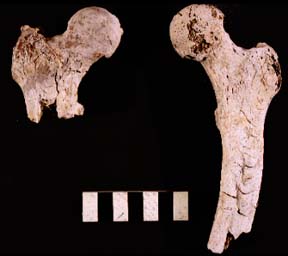



The contents of the analyzed cremation urn--grave goods and bones--give clues to the life of its occupant. Among the bones and ashes from this cremation burial are three femurs (two left and one right), all from human females. This indicates that there are at least two individuals' cremated remains in this assemblage. Parts of at least two skulls survived as well, allowing the ages of the women represented to be estimated. One was approximately forty years old and the other was in her mid-twenties.
Why two women? The tombstone only indicates one burial.** Several explanations are possible. One explanation for the extra bones is that the cremated remains of another family member or slave may later have been placed in the same urn with the original burial. Or the other bones may have been added at a later date to increase the value of the urn and its contents for the market in antiquities. This commonly occurs in cases where locals discover ancient burials and try to make a profit from their findings. The fact that several animal bones were also found in the cremated remains likewise suggests this is a viable explanation, since animals were rarely cremated with their owners. It is unlikely we will ever know the true story.
**Please note: this "assemblage" was created solely for educational purposes. While the cremation urn KM 2903 and its contents may reflect an actual burial (it was purchased in the 1920's in Puteoli, Italy), the other objects in this "assemblage" (columbarium, inscription, and melted glass) do not come from the same archaeological context. A full explanation of this class project is found on the introductory page for this website.